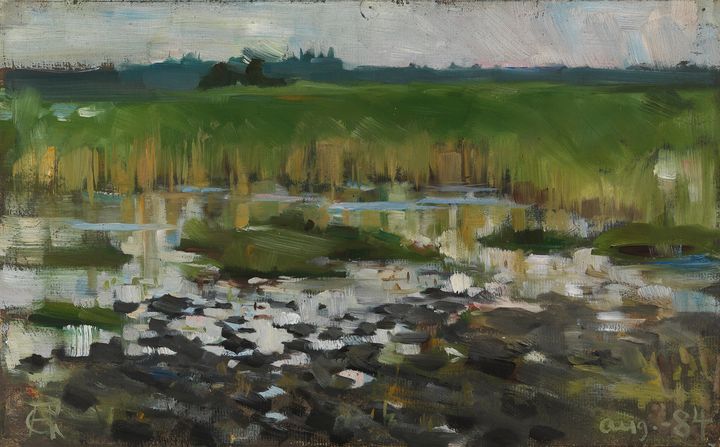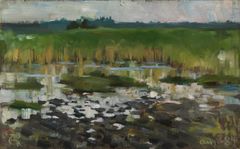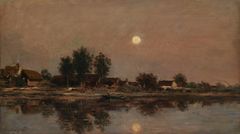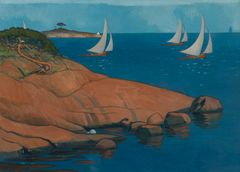Water and Life dives into the depths of the sea and sails to busy ports
The exhibition at the Sinebrychoff Art Museum explores humans’ journey to water from the seventeenth century until the present day. It invites you to reflect on our relationship with water, one of the essential elements for life.

Water and Life
15 February–11 August 2024
Sinebrychoff Art Museum
Life on this planet began with water. Water covers almost three quarters of the Earth’s surface and is essential for life. The exhibition at the Sinebrychoff Art Museum explores humans’ journey to water from the seventeenth century until the present day. The exhibition portrays water through art and natural science.
“I feel that the museum has an obligation to partake in discussions of major importance to society and bring its own perspectives to light. The Life Under Threat exhibition in 2020 dealt with the relationship between animals and humans. Now the exhibition focuses on water. I hope that, through art, people will awaken to the beauty of our planet", says Museum Director Kirsi Eskelinen.
The Water and Life exhibition consists of paintings, sculptures, graphic art and contemporary art executed in a range of methods, dating from the seventeenth century to the present day mainly from the Finnish National Gallery's own collection. The artists exhibited include: Jean-Baptiste Camille Corot (1796–1875), Charles-François Daubigny (1817–1878), Ellen Thesleff (1869–1954), Akseli Gallen-Kallela (1865–1931) and Heli Rekula (1963–). The exhibition also includes treasures of the sea, such as fossils and shells. Salla Heino is curator of the exhibition.
Humans and water
Humans’ relationship to water is intricate, and it has changed over time. For a long time, humans went out on the water only when it was necessary. Along with conquest, exploration and trade, fishing was one reason to set out sailing. Artists have portrayed battles and lordship of the seas in their seascape paintings. Not only have they portrayed heroic deeds but also the darker side of seafaring, such as shipwrecks and destruction. Artists were aware of the power and volatility of water, which is evident in their works.
It was not until industrialization and urbanization that the coastal shores became appealing to people, and they began to spend time by the water for leisure. Beach life and leisure by the water became more common in the nineteenth century. Artists were also devoted to nature. Artists in the Barbizon School especially, such as Jean-Baptiste Camille Corot (1796–1875) and Charles-François Daubigny (1817–1878), focused on eternalizing moments spent in nature. Nature or landscape were reason enough to paint — there was no need to depict higher powers, nobility or morality.
Research and curiosity have propelled humans all the way to the Arctic icebergs and to the depths of the seas. The aquatic environment and research of it were great sources of inspiration in the nineteenth century. New information about animals became available and the fear that the creatures of the sea aroused subsided. Humans became more familiar with and more comfortable around water. The deepest nooks of the seas are, however, still a mystery even today, although the advancement of diving technology continually generates new knowledge.
“Modern technology allows researchers to reach depths of thousands of metres, which is a much shorter distance compared to how far humans have travelled when exploring space. New species of organisms are constantly being discovered at the bottom of the seas", says curator of the exhibiton Salla Heino.
Ebb and flow
Movement is a defining feature of water. Water is all around us, not just in the ebb and flow of the waves and surface. It changes from one state to another. Waterways provide transportation routes for people, goods, flora and other life forms.
Travelling on land or at sea is a way to perceive our world’s boundaries. Artists have also travelled to certain shores and waters. The works allow us to travel to the time and place where a given artist has been and, in the best case, imbue the same experience on us.
“The works take us to new places. We can tangibly explore geographical differences and details in the water and coastal shores. To give an example, Venny Soldan-Brofeldt (1863–1945) painted Archipelago landscape (1900) on the shore of the Baltic Sea. You can clearly see that the coastal rock is granite, smoothed over during the Ice Age", Heino explains.
The Water and Life exhibition takes you on a journey to admire landscapes and relax by the varying essence of water. It also invites you to explore the natural science of water and reflect on our relationship to water.
Exhibition curator:
Salla Heino is curator at the Sinebrychoff Art Museum.
Lenders of the works:
Gallen-Kallela Museum, Espoo
Gösta Serlachius Art Museum, Mänttä
John Nurminen Foundation, Helsinki
National Library of Finland, Helsinki
Ostrobothnian Museum, Vaasa
Private lenders
Oy Sinebrychoff Ab supports the Sinebrychoff Art Museum.
Keywords
Contacts
Kirsi EskelinenMuseum Director
Tel:+358 (0) 294 500 490Kirsi.Eskelinen@siff.fiSalla HeinoCurator
Tel:+358 (0)294 500 461salla.heino@siff.fiMerja HäikiöMarketing and Communications Specialist
Tel:+358 294 500 482merja.haikio@siff.fiImages



Links
The Sinebrychoff Art Museum
Tickets: Museum entry €20, Concessions €12, Museum Card, free of charge, Under 18s €0. Museum ticket purchased online €18.
Admission to the Home Museum and permanent collection on the 2nd floor is free.
Opening hours: Tues, Thurs, Fri 11–18, Wed 10–20, Sat–Sun 10–17, Mon closed.
Guided tour bookings: Finnish National Gallery service sales, +358 294 500 500 (Mon–Fri, 10–14) sales@fng.fi
Contact: Sinebrychoff Art Museum, Bulevardi 40, 00120 Helsinki, Finland, +358 294 500 460, www.siff.fi
Facebook @siffmuseo | Instagram @Sinebrychoffartmuseum | Twitter @Sinebrychoffart
The Finnish National Gallery is a national organisation for the visual arts. It runs three of Finland’s best-known museums: the Ateneum Art Museum, the Museum of Contemporary Art Kiasma and the Sinebrychoff Art Museum. It also manages the national art collection and its archives, develops Finnish cultural heritage, and promotes art to the wider public.
www.kansallisgalleria.fi/en
Alternative languages
Subscribe to releases from Sinebrychoffin Taidemuseo
Subscribe to all the latest releases from Sinebrychoffin Taidemuseo by registering your e-mail address below. You can unsubscribe at any time.
Latest releases from Sinebrychoffin Taidemuseo
Inbjudan till utställningens förhandsvisning tisdagen den 11.2 kl. 14: Antikens hjältars äventyr och medryckande berättelser lockar publiken till Konstmuseet Sinebrychoff29.1.2025 08:00:00 EET | Pressmeddelande
På hjältarnas resa får vi uppleva fartfyllda och farliga situationer. Antikens hjälteberättelser underhåller oss fortfarande efter tusentals år och är starkt närvarande i vår kultur. Utställningen presenterar centrala hjältar i den grekiska mytologin. Följ med på äventyret! Välkommen på utställningens förhandsvisning tisdagen den 11.2 kl 14.00. Anmäl dig till: merja.haikio@siff.fi
Kutsu näyttelyn ennakkoesittelyyn ti 11.2. klo 14: Antiikin sankareiden seikkailut ja koukuttavat tarinat tempaavat mukaansa Sinebrychoffin taidemuseossa29.1.2025 08:00:00 EET | Tiedote
Sankareiden matkassa pääsemme kokemaan vauhtia ja vaarallisia tilanteita. Antiikin sankaritarinat viihdyttävät meitä vielä tuhansien vuosien jälkeen ja elävät vahvasti kulttuurissamme. Näyttely esittelee kreikkalaisen mytologian keskeiset sankarit. Lähde mukaan seikkailuun! Tervetuloa näyttelyn ennakkoesittelyyn ti 11.2.2025 klo 14.00. Ilmoittaudu mukaan: merja.haikio@siff.fi
You are invited to an exhibition preview at 14:00 on Tuesday, February 11. Gripping tales of ancient heroes and their adventures will captivate you at the Sinebrychoff Art Museum29.1.2025 08:00:00 EET | Press release
On the heroes’ journeys we get to experience action and perilous situations. Ancient hero tales still entertain us after thousands of years and live on strongly in our culture. The exhibition features the main heroes of Greek mythology. Join us on the adventure! You are welcome to the exhibition preview at 14.00 on Tuesday, 11.2.2025. Register: merja.haikio@siff.fi
Lyssna på antikens hjältesagor och försjunk i Spaniens myter på Konstmuseet Sinebrychoff under år 202519.12.2024 11:53:40 EET | Pressmeddelande
Under nästa år visar Konstmuseet Sinebrychoff två växlande utställningar. Först ut är Antikens hjältar. När vi följer med på hjältens resa får vi uppleva stora känslor och hisnande överraskningar. I september öppnar utställningen Spanien bakom myten som presenterar det kittlande Spanien och dess mytiska bildvärld. Utställningen visar målningar av spanska konstnärer från 1800- och 1900-talet.
Sinebrychoffin taidemuseossa kuullaan antiikin sankaritarinoita ja uppoudutaan myyttiseen Espanjaan vuonna 202519.12.2024 11:53:40 EET | Tiedote
Sinebrychoffin taidemuseossa on ensi vuonna esillä kaksi vaihtuvaa näyttelyä. Antiikin sankarit ovat ensimmäisenä näyttämöllä. Sankareiden matkassa pääsemme kokemaan suuria tunteita ja uskomattomia juonenkäänteitä. Syyskuussa avautuva Espanja myyttien takaa -näyttely esittelee kiehtovaa Espanjaa ja sen myyttistä kuvastoa. Näyttelyssä nähdään espanjalaisten taiteilijoiden maalauksia 1800-1900-luvuilta.
In our pressroom you can read all our latest releases, find our press contacts, images, documents and other relevant information about us.
Visit our pressroom